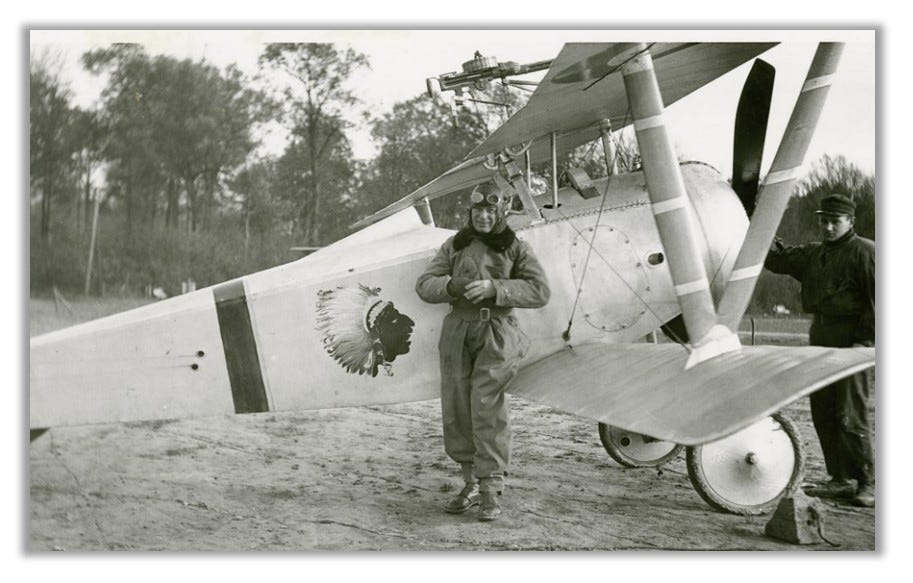TDIH: The Lafayette Escadrille
More than 200 American pilots would serve in the French Air Service, known as the Service Aéronautique, during World War I. The most elite of the group were assigned to their own squadron.
On this day in 1916, American pilots take to the skies at the Battle of Verdun. They’d volunteered to fight, even though the United States had not yet entered World War I.
At least for the time being, these men flew under French command.
More than 200 American pilots would serve in the French Air Service, known as the Service Aéronautique, during World War I. Unofficially, these men were known as the Lafayette Flying Corps. The most elite of the group—the “Valiant 38”—were assigned to their own squadron, the Lafayette Escadrille.
The pilots in this squadron have been called “the founding fathers of American combat aviation.”
They were an interesting bunch, but perhaps that’s to be expected from a crew so willing to take on new adventures in the sky? Perhaps befitting their sense of adventure, the squadron even had two lion cubs as mascots—one named Whiskey and one named Soda.
“The Escadrille reminds me a lot of fighter squadrons I’ve been in,” Former Air Force chief of staff General Merrill McPeak says. “The cast of characters is quite colorful—the good and the bad, the skilled and the unskilled, the lucky and the unlucky. It was a very, very risky business. So it attracted some weird and colorful people, which is true even today.”
But there was more than just a sense of adventure. Historian Philip M. Flammer concludes that these weren’t just elite pilots, they were “elite men.”
“Adventure without the dangers of combat was open to any airman,” he says. “The American pilots did well because, by and large, they viewed the conflict as a crusade, a contest, as it were, between good and evil. In a position to take part, they felt a compelling obligation to do so.”
Several people are credited with coming up with the idea for an American squadron in the first place.
One was aviator William Thaw II, an aviator who was in France marketing his new automatic stabilizer when war broke out. A second was Norman Prince, a prominent lawyer who’d learned to fly, and the last was Edmund Gros, a physician then working with the American Ambulance Corps.
Each made his own contribution in convincing the French to turn the idea of American help into reality, but it wasn’t easy. The French were worried that foreign volunteers could turn out to be German spies. On the other side, some prominent Americans in Paris worried that such a move might violate American neutrality.
In the end, those advocating for an American squadron got their way. It didn’t hurt that some of the French actively wanted American aviators fighting alongside them: Perhaps it would push public opinion in the United States away from neutrality.
The squadron was officially authorized by the French Air Department in March 1916, and the pilots entered their first combat on May 13.
Today, pilots have state-of-the-art technology, so it can be hard to imagine what pilots in 1916 were getting themselves into. Air combat was then still new. Airmen sometimes took to the skies carrying rifles and pistols. Weapons affixed to the plane had to be developed. Pilots such as Robert Soubiran (pictured) would reach up from cockpits to fire their wing-mounted guns.
Yet they learned, they fought, and they persevered . . . and they brought all their new knowledge and experience home with them.
“I really look at [the pilots] as the founding fathers of the Air Force,” Lt. Col. Nick Rutgers concludes. He is the great-grandson of one of the Lafayette Escadrille pilots. “They were jumping into a completely new realm of combat just a little more than 10 years since the inception of aviation. What they did, who they were, and what they represent is pretty incredible . . . .”





Thank you, Tara. My Grandfather was a Pilot in France during WWI, He was a Forward observer taking photos of the lines and crossing into enemy territory to do so, he was shot down many times, and once, his goggles were shot off his head, but landed in the cockpit, so he had a souvenir of his split metal goggles that are now in the Smithsonian Institute. Many other items were donated. Aerial photo's and a Huge scrap book he made during the war. He was not part of the French Air Service as far as I know, but still, he is my hero.
I find it interesting that 10 years after airplanes were invented that American men would flock to France to fly such primitive planes into combat and under the French flag. These people were either a bit crazy or full of daring, or both. But they did it and maybe, they were the actual beginning of the United States Air Force. Thank you Tara for finding such items of history to continue my daily history lessons.